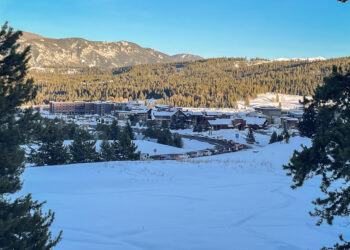By Kris Inman EBS CONTRIBUTOR
Last month an article about a bear being captured and removed in Bozeman brought concerns regarding the humaneness of the use of culvert traps. We at Bear Smart Big Sky are glad to hear these concerns because this means that you, like us, care about bears.
To answer these concerns, I want to share how culvert traps work.
These traps are similar to a large culvert. Open on one end with a ramp and door, they are rigged so that once the bear pulls on the bait, the door is triggered and closes. They are long enough that a bear has to move to the end of the culvert-shaped tube before it can reach the bait. Also, the door closes quickly, well before the bear can make it back around to the door. Both the length of the trap and the quickness of the door work in concert to reduce the risk of the bear being injured by the door. Culvert-type traps are the safest method to use for bears and the public. All traps have bedding and water containers in them for the bear’s welfare.
That said, why would a bear be captured in a culvert trap anyway? There are two possible reasons.
The first is for wildlife research. Wildlife biologists capture, radio-collar and release bears back into the wild to answer questions that protect and conserve them. I’ve worked on several such studies. Data about the number of cubs born, how many bears die, and what they died from is used to predict population trends and drive management decisions for both black bears and grizzlies.
The second reason to trap bears arises when bears and people have interacted negatively, like the case of the bear that was removed earlier last month. In these cases, a bear is captured and relocated or euthanized based on the bear’s history, behavior and the conflict situation.
The frequency of human-bear interactions is increasing and relates to the growing popularity of wild areas. The population of Gallatin County has doubled since 1990 and has grown three times faster than the entire state, as reported by Headwaters Economics. Madison County to the west is not far behind.
As the urban meets wildlands, bears are adjusting quickly. They find trash and open garages lead to a more consistent food source than what nature provides.
Bears searching out trash usually follow the availability of natural food. In a drier year, trends in conflicts tend to increase when natural food sources like berries and grasses are scarcer. This year, where precipitation in the Big Sky area is ranging from 135-230 percent of normal, based on an Aug. 7 report by the Montana Natural Resources Conservation Service, we would expect to see bears return to the readily available wild food sources. And some do.
However, according to Montana Fish, Wildlife and Parks bear specialist Kevin Frey, “Higher quality natural foods like berries can be sporadic and generally diminish before bears are ready to den for the winter. Bears are opportunistic, and will return to ‘easy’ food sources like garbage and birdseed if they are available.
Once bears receive this food reward over and over again, it is very difficult to change their behavior.”
In Big Sky, over 70 percent of homeowner associations require that their homeowners and visitors use a bear-resistant trash can, reports Ben Holst, Bear Smart Big Sky Council member.
This is a step in the right direction. Frey says it will require consistent use of bear-resistant trash cans to break the cycle of habituated bears in Big Sky before we see the end of culvert traps. It is a day he and the Bear Smart Big Sky Council look forward to.
For roughly $6 more a month, you can have a bear-resistant trash can. Become an ambassador for change and help move us into this next era of protecting and conserving bears. Do your part and be bear smart.
Remember to follow Bernadette Bear on social media @bearsmartbigsky to learn how to make Big Sky’s story a positive one for bears, people and wild places.
Kris Inman is the community partnerships coordinator for the Wildlife Conservation Society and oversees the Bear Smart Big Sky campaign.













